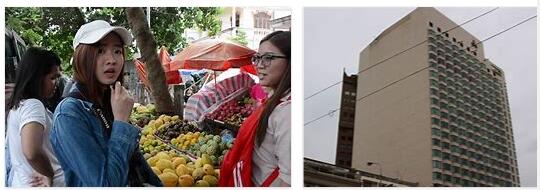Agriculture
Despite industrial growth and the decreasing importance of agriculture, Vietnam is still an agricultural country. In 2016, 41.9% of the workforce was employed in the agricultural sector, which contributed 16.3% to the creation of GDP. rice is by far the most important staple food and is grown on around 45% of the agricultural area. Vietnam developed into the largest rice exporter and the second largest coffee exporter in the world. Other important agricultural products for export are pepper, rubber, cashew and coconuts, tobacco, sugar cane, jute, tea and cotton. The cultivation of maize, millet, cassava, potatoes, vegetables and fruit (especially bananas, oranges, pineapples) is used for personal use. Livestock farming plays a major role; pig, buffalo and cattle and chicken breeding dominate.
Forestry: The forest area (2016) amounts to 48.1% of the country’s area. The country still suffers from the effects of the destruction of forests by chemical weapons during the Vietnam War (until 1975). As a result of slash and burn, settlement and road construction, the mining of mineral resources and the creation of plantations, the forest area has been further reduced in the period that followed. The government has been trying to contain and control logging since 1992 (ban on exporting wood). The impact is (2014) 26.7 million m 3 ; over three quarters of this is used as firewood. State reforestation programs are not yet showing the hoped-for effect, as large areas of forest are also being lost through illegal logging.
Fisheries: Deep-sea fishing traditionally plays an important role in the economy (catch volume in 2014: 6.3 million t). Fish and seafood are among Vietnam’s most important export goods. Aquacultures such as shrimp and pangasius farming, which are concentrated in the Mekong Delta, have increased particularly sharply in recent years (production volume in 2014: 3.4 million t).
Natural resources
Mineral resources are found almost exclusively in the north of the country (Quang Ninh Province). Hard coal is important, and among other things, Chrome ore, barite, gypsum, phosphate, kaolin, salt and gold mined. Vietnam has large deposits of crude oil and natural gas in the offshore area off Vung Tau in South Vietnam. Crude oil is an important export. Vietnam has had its own refinery in Dung Quat since 2009 (a second refinery was completed in 2018), thereby reducing its import dependency for petrochemical products.
Energy industry
The electrical energy is mainly generated by natural gas (43.9%) and hydroelectric power plants (30.1%), the rest is provided by coal (21.1%) and oil power plants. The rapid economic growth leads to a sharp increase in electricity consumption; the annual growth rates are around 15–20%. Numerous new power plants are under construction or in the planning stage to meet the demand. Due to the regionally different availability of energy sources, the north generates electricity surpluses due to the large hydropower potential and the coal deposits, while the south, poorer in primary energy, suffers from a lack of electricity, especially in the dry season.
Industry
Industry has developed into the most dynamic economic sector since the early 1990s. The industrial sector (including mining and construction) generated (2016) 32.7% of GDP, the share of employees was 24.8% of the workforce. The industrial development is regionally very uneven. Important locations of the socialist industrialization strategy in the north, which were characterized by heavy industry mainly due to the raw material deposits (the iron and steel industry, chemical and building materials industry), suffered a loss of importance. The industrial development in the light industrial south with the growth center of Ho Chi Minh City is dynamic (including the food, textile, clothing, plastics and electronics industries). This development is favored by foreign direct investments and successful Vietnamese private companies, which can be found mainly in the south of the country. The main industrial locations are Hanoi, Haiphong, Da Nang and Ho Chi Minh City.
Service
Only with the reform process (Doi Moi) from 1986 onwards did the demand for corporate and private services develop. The development of market economy structures with trading companies, financial services, etc. is still in its infancy. In 2016, around half of GDP was generated in the service sector. It employs around a third of all employed people.
Tourism: Due to significant improvements in the tourist offer, the number of foreign guests rose from 670,000 (1993) to 12.9 million (2017). Most of the visitors come from China, the USA, South Korea, Japan and Taiwan. Income from tourism in 2015 amounted to US $ 7.3 billion. The country has great scenic and cultural-historical tourism potential. Scenic are z. B. in the north the Halong Bay with its limestone formations as well as the mountain regions, the beaches in the central region and in the south of the country as well as the Mekong Delta. Visit healthinclude.com for Vietnam travel plan.
Cities like Hanoi with their Chinese and colonial heritage are cultural and historical attractions; Huê , the former imperial city with the forbidden city and interesting tombs as well as Hoi An as a traditional trading center in central Vietnam; Nha Trang as the center of Cham culture and Ho Chi Minh City as a pulsating metropolis.
Transportation
Since the beginning of the system transformation, the transport infrastructure has been improved with foreign support. Nevertheless, the road network and the railway network are largely in poor condition. The main artery, together with the parallel coastal road, forms the 1,730 km long rail link between Hanoi and Ho Chi Minh City. Inland navigation plays a major role in the delta areas. The main overseas ports are Haiphong, Da Nang and Ho Chi Minh City. The largest international airports are in Hanoi and Ho Chi Minh City.
